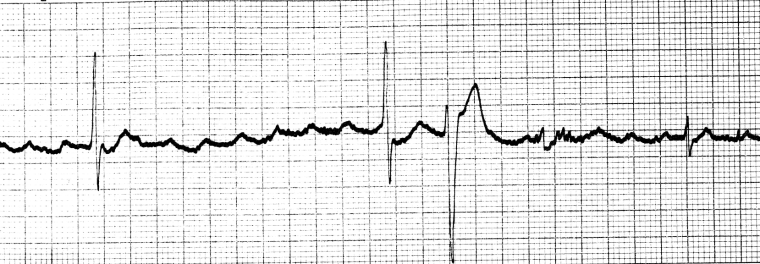Approach
History and physical examination can provide clues towards the diagnosis of digoxin overdose. ECG, digoxin level, electrolytes, and renal function tests should be ordered in all patients who present with suspected digoxin toxicity or exposure. Digoxin toxicity should be suspected in patients with a history of heart failure or atrial fibrillation, particularly in patients with renal insufficiency. A drug history should be taken, including any supplements, herbal remedies, over the counter medications and any plant ingestions, with particular attention to the use of p-glycoprotein/cytochrome 3A4 inhibitors.
History and exam in acute toxicity
In acute digoxin toxicity, patients or family members may provide the history of exposure or suicidality. Acute digoxin toxicity is characterized by patients being asymptomatic for minutes to hours after an exposure to digoxin, followed by a rapid deterioration. The symptoms usually include nausea, vomiting, anorexia, diarrhea, and/or abdominal pain (less common), and may include palpitations, syncope and dyspnea. Acute digoxin toxicity may cause virtually any dysrhythmia. The 2 medications used most commonly in clinical practice are digoxin and digitoxin.
History and exam in chronic toxicity
Chronic digoxin toxicity is more common in elderly patients. It has a more indolent course with a less obvious presentation. It should be considered if the following symptoms are present: nausea, anorexia, abdominal pain, weakness, fatigue, palpitations, syncope, dyspnea, disturbances of color vision with a tendency to yellow halos (xanthopsia), blurred vision, and diplopia. Patients most often present with gastrointestinal signs (anorexia and vomiting) and generalized nonspecific complaints (generalized weakness and malaise), but could also present with central nervous system depression.
Investigations to order
A 12-lead ECG should be performed in all patients who present with suspected digoxin toxicity or exposure.
Serum digoxin concentrations should be measured, but are only truly reflective after distribution is complete (4 to 6 hours after the last dose). Levels are drawn immediately on presentation, but often a second level will be required, as levels drawn too early are not reflective of distributed levels. There is no exact serum digoxin concentration (SDC) that is predictive of chronic toxicity. There are a number of factors that can affect a patient's susceptibility to digoxin (e.g., hypokalemia, volume status, comorbidities, age, and chronic disease).[22] Patients not taking digoxin may have measurable digoxin levels that result from high circulating amounts of endogenous digoxin-like substances (EDLS). Conditions such as pregnancy, renal failure, and hypothermia are associated with EDLS; however, levels rarely exceed 0.2 nanograms/mL in these patients. Also, spironolactone and nondigoxin cardioactive corticosteroids such as digitoxin and oleandrin can cause false-positive elevations of digoxin levels. Additionally, Asian, Siberian, and American ginseng are known to interfere with serum digoxin measurements using fluorescence polarization technology.[25]
Serum potassium concentrations are important as a marker for prognosis in acute digoxin toxicity, and also reflect the severity of the toxicity.
Renal function should be assessed as this influences the rate of clearance of digoxin from the bloodstream.
In addition, serum magnesium should be measured, as low levels exacerbate cardiac manifestations of digoxin toxicity.
Diagnostic findings in acute toxicity
Classically, patients with acute digoxin toxicity have:
Dysrhythmias, which are associated with increased automaticity and decreased atrioventricular (AV) conduction (e.g., atrial flutter and atrial fibrillation with high-degree AV block, nonparoxysmal atrial tachycardia with block, accelerated junctional rhythms, and/or bidirectional ventricular tachycardia).[26] Premature ventricular contractions are the most common dysrhythmia. Bigeminy or trigeminy occur frequently. The only rhythm disturbances that are not definitively associated with digoxin toxicity are supraventricular tachyarrhythmias with a rapid ventricular response: for example, supraventricular tachycardia and sinus tachycardia.
Hyperkalemia (≥5.5 mEq/L).
Elevated digoxin serum concentration above 0.9 nanograms/mL in patients taking digoxin for heart failure.[24][Figure caption and citation for the preceding image starts]: ECG showing digoxin toxicityFrom the collection of Dr Robert S. Hoffman [Citation ends].

Diagnostic findings in chronic toxicity
Chronic digoxin toxicity is most often associated with:
Bradyarrhythmias (ventricular tachyarrhythmias also occur)
Normal or low serum potassium concentrations (they can also be high)
Elevated serum digoxin concentrations (above the recommended therapeutic levels of <1 nanogram/mL in patients taking digoxin for heart failure)
Use of this content is subject to our disclaimer